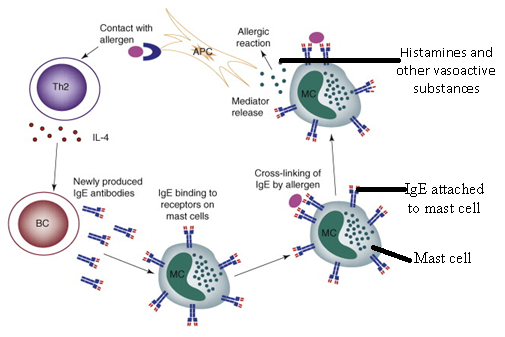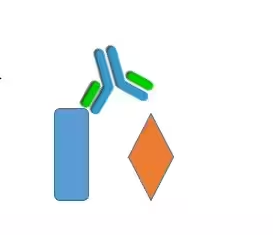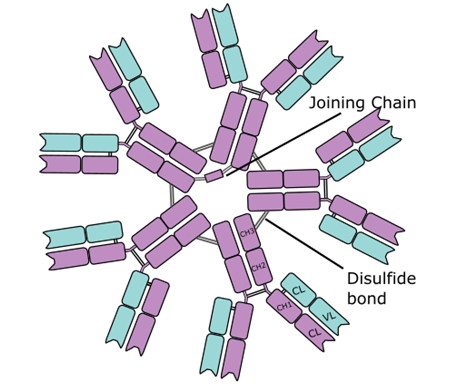Antigen is any substance or molecule that can trigger an immune response in an animal. An antigen is basically anything that is foreign to the body and which can react specifically with an antibody. An understanding of the basic characteristics of antigens and/or pathogens that spark immunological response in the body is vital for us to know how antigen-antibody reaction actually occurs and what this complex reaction implies in clinical terms. Antigens consist of microorganisms such as viruses, bacteria, fungi and parasites or worms.
They may also include proteins, glycolipids, polysaccharides, and substances or molecules released by any of these pathogens, and which the immune system of the host organisms considers to be non-self-molecules. In transplantation immunology where graft or organs are being transplanted from one host to another, the recipient immune system (especially in the case of non-identical twins) can sometime see the transplanted tissues or cells as antigens because they may contain some markers which the non-self-receiver’s immunological makeup sees as non-self. However, not all foreign molecules that enter the body are capable of sparking up an immunological response that leads to antibody production.
Antigens that induce the production of antibodies by the immune system are generally called immunogens. All immunogenic substances are always antigenic because they are able to react and be recognized by a specific antibody. However, some antigens (especially those with low molecular weight) are not immunogenic in nature even though they may exhibit some features of an antigen and are said to be antigenic. Substances with low molecular weight and which are not immunogenic by themselves but can become immunogenic when coupled to a carrier molecule such as a protein (which is immunogenic) are generally called haptens.
Drugs can sometimes become immunogens when they spark up allergic reactions in the host taking them. Many biologically and chemically important substances such as drugs, steroid hormones, and peptide hormones can also serve as haptens. Dinitrophenol (DNP), an organic compound is a typical example of a hapten. The phrases antigen and immunogens are often used interchangeably.
Immunogenicity is the ability of a substance to elicit an immune response (both humoral and cell-mediated immunity), and this phenomenon is usually exhibited by immunogens. Antigenicity is the property of an antigen that allows it to react specifically with the product of the specific immune response (i.e. antibodies or receptors of T cells).
Though related and often confused in immunological discussions, immunogenicity and antigenicity are two distinctive terms which varying immunological properties and functions as it relates to antigens. In immunological terms, antigens are generally referred to as substances that can react specifically with the antibody receptor of B cells or T cell receptor when complexed or joined with major histocompatibility molecule (MHC).
Antigens are of two types, and they are endogenous and exogenous antigens.
ENDOGENOUS ANTIGENS
Endogenous antigens are naturally occurring antigenic substances found within an animal and which are unique to every individual. They are generally responsible for tissue rejection experienced during the transplanting of cells or tissues from one host (donor) to another (recipient). Typical examples of endogenous antigens are allogenic antigens which are largely controlled by antigenic determinants that differentiate one individual of a species from another. They are specific cell markers found on the surfaces of cells and tissues and are seen as antigens by the immune system when they move from one person to another in scenarios of blood transfusion or tissue transplant.
EXOGENOUS ANTIGENS
Exogenous antigens are foreign molecules or substances that are external to the body of a host. They include microbes and their products, proteins of high molecular weight and polysaccharides as well. Exogenous antigens are responsible for a handful of infectious diseases in man, and they elicit both specific and non-specific immunological attack upon entry into the body of a host.
REFERENCES
Abbas A.K, Lichtman A.H and Pillai S (2010). Cellular and Molecular Immunology. Sixth edition. Saunders Elsevier Inc, USA.
Actor J (2014). Introductory Immunology. First edition. Academic Press, USA.
Alberts B, Bray D, Johnson A, Lewis J, Raff M, Roberts K and Walter P (1998). Essential Cell Biology: An Introduction to the Molecular Biology of the Cell. Third edition. Garland Publishing Inc., New York.
Bach F and Sachs D (1987). Transplantation immunology. N. Engl. J. Med. 317(8):402-409.
Barrett J.T (1998). Microbiology and Immunology Concepts. Philadelphia, PA: Lippincott-Raven Publishers. USA.
Jaypal V (2007). Fundamentals of Medical Immunology. First edition. Jaypee Brothers Medical Publishers (P) Ltd, New Delhi, India.
John T.J and Samuel R (2000). Herd Immunity and Herd Effect: New Insights and Definitions. European Journal of Epidemiology, 16:601-606.
Levinson W (2010). Review of Medical Microbiology and Immunology. Twelfth edition. The McGraw-Hill Companies, USA.
Roitt I, Brostoff J and Male D (2001). Immunology. Sixth edition. Harcourt Publishers Limited, Spain.
Zon LI (1995). Developmental biology of hematopoiesis. Blood, 86(8): 2876–91.
Discover more from Microbiology Class
Subscribe to get the latest posts sent to your email.





